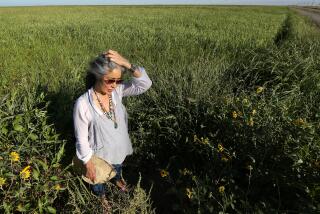Reluctant but Resilient Farmer Changes Course
- Share via
MAYVILLE, N.D. — Long after the machinery was sold and the auctioneer gone, Elroy Lindaas would rise early, pull on gray cowboy boots and wander the frost-sequined fields, longing for his old routine.
Now, months later, he’s still mulling over the past.
“I think back, of my parents and grandparents, wondering what they would think,” he says, surveying the soil his Norwegian ancestors first saw from a covered wagon. “I wonder what could have been and what has been. I wonder, ‘Did I make the right decision?’ But I’m convinced that I have.”
At age 62, Lindaas has given up farming.
A North Dakota state senator, Lindaas had hoped to farm well into his 70s, then turn over his business to his only son. But after losing money for eight of the last 10 years, he changed course. His head won over his heart.
And on June 15, the auctioneer came calling.
All seven Lindaas children were there, some having flown in from California, Ohio and Idaho, for a reunion and farewell to a 120-year tradition of growing food on a patch of prairie in a township that bears the family name.
“It was like a death,” says Janice Lindaas, Elroy’s high school sweetheart and wife of 43 years. “It still hurts to talk about it.”
After the auction ended, the kids, ages 25 to 42, posed for a family photo with their parents on Lindaas’ 1971 John Deere tractor--the only one the frugal farmer ever bought new. In the picture, Lindaas wears bluejeans, a brown jacket and a dazed smile.
“They said when you crawled out of the tractor, you didn’t look so good,” Janice gently reminds her husband of the sadness in his eyes that his children saw the day he said goodbye to a career.
As with so many other farmers, sagging crop prices forced Lindaas’ hand; wheat, which sold at about $4.50 a bushel in 1995-1996, dropped to about $2.50 a bushel.
Then there were the kinds of calamities seen in disaster movies: blizzards, droughts and floods that sometimes withered his crop with disease.
Still, Lindaas is luckier than many who quit.
He held on to his land. A neighbor rents it, and Lindaas, trim and without a trace of gray in his auburn hair, helped him harvest the crop this fall.
He also has Social Security benefits, his modest legislator’s salary (lawmakers meet once every two years) and little debt.
“I’m sure I could have negotiated with the banker,” he says. “But if you’re going in the hole, do you keep digging?”
More and more farmers are reaching that conclusion.
“We’re seeing people financially forced out and voluntarily quitting because it’s so unprofitable,” says Jeff Knudson, administrator of the state’s Agriculture Mediation Service.
The number of farms in North Dakota has dropped from 45,000 in 1970 to 31,000 last year. Mechanization and consolidation account for part of that decline, but here, as elsewhere, family farms are disappearing.
Lindaas says the number of farmers in his township has shrunk from 28 to about a dozen in the last 15 years.
Once there was a school named after the family, but it’s a memory now, like the photos lined up on Elroy’s living room wall.
There is a sepia portrait of Endre, the hearty homesteader who arrived as a teenage orphan from Norway, dug a cave from the hillside for shelter and courted his bride-to-be, Antoinette, by letter.
He farmed for 40 years.
Then there are black-and-white images of his son, Eddie, soft-spoken and gentle, who was born in the bedroom of this house. He and his wife, Emma, had a simple family rule: in the fields by 7 a.m., out by 6 p.m. for dinner.
He farmed for 40 years.
And finally, there are bright color photos of Elroy, who was born in the same bedroom as his father, with Janice and their brood of seven, dressed in their finest, celebrating a family wedding.
He farmed for 41 years.
Lindaas says his son, Jeff, 34, holds out hope he’ll take over the farm, but chances are slim.
Lindaas stays busy with his legislative work and small farm projects.
“I’m resilient,” he says. “I’m not suffering. I’m healthy. I enjoy life.”
Lindaas has a band, the Hay Shakers, who entertain in his huge white barn during summer weekends.
The barn also is home to political rallies, and Lindaas sometimes writes songs for the occasion. This year he penned an untitled tune about leaving farming.
Without prompting, he picks up his acoustic guitar, lifts a knee, strums and, in a reedy voice, begins singing about the three generations of Lindaas’ farmers.
” . . . Just this last summer we hung up the plow,
There’s life after farming, I’m told.”
As he reaches the last verse, he stops.
“I’m sorry,” he says, almost inaudibly.
Unable to go on, he hands over the words.
The song ends:
“But this place will always be home.
Yes, this place will always be home.”
More to Read
Sign up for Essential California
The most important California stories and recommendations in your inbox every morning.
You may occasionally receive promotional content from the Los Angeles Times.













